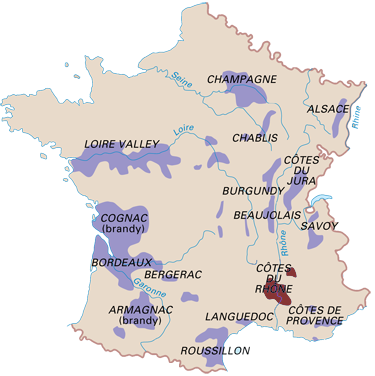
Châteauneuf-du-Pape

Châteauneuf du Pape is located in the driest part of the Rodain Valley. It is frequently affected by mistral winds which are responsible for bad crops. Vineyards located on the grounds of this appellation cover ca. 3200 ha and yield 110 thousand hectolitres of wine per year. Red wines constitute the majority among the produced wine. It is worth noting that appellation rules do not allow for producing rosé wines. The appellation covers the following communes: Châteauneuf du Pape, Bédarrides, Courthézon, Orange and Sorgues. Châteauneuf Du Pape is an interesting French appellation, by law it is allowed to produce wines from 18 different grape varieties (13 were allowed until 2009); this leaves producers a lot of room to show off their talents. In spite of such possibilities, mainly 4 varieties are used: Grenache (Noir) - 72% of plantation, Syrah - 10.5% and Mourvedre - 7%, therefore it is easy to conclude that red wines are dominant here.
Although the name of the town of Châteauneuf-du-Pape (Pope's new castle) is relatively new as it comes from the 19th century, it refers to a much older story. Symbols of papal power embossed on bottles of wine from the Rodain Valley are an indication of the period referred to in the history of the Church as the Avignon Papacy. The grounds for this conflict, which was the longest in the history of the church, was the disagreement between the King of France, Philip IV Le Bel and Pope Boniface VIII (Benedetto Gaetani). The King wished to subordinate the papacy at all cost, while the Pope could not agree to this intent. Moreover, Pope Boniface VIII issued a bull where he forbade the collection of taxes from the clergy without the consent of the Pope. Boniface VIII also displeased the King by stating the supremacy of clerical authority over secular power. During the culmination point, Philip Le Bel ordered his Chancellor to capture the Pope and imprison him in Anagni. Although he was released soon afterwards, Boniface did not recover from the shock and died in 1303. Two years later, a new Pope was elected, a candidate of the French King, Bertrand de Got, who took the name of Clement V. Under the threats of Philip Le Bel and due to antifeudal riots in Rome, he agreed to transfer his residence to Avignon in 1309 where an impressive palace complex was constructed for him. This was also the time when vineyards started to develop. A real bloom of the vineyards can be attributed to Celement's successor - John XXII. He is known as the great preacher of winemaking and he chose the town of Châteauneuf du Pape for his summer residence, and built the Pope's new castle, Châteauneuf du Pape, in place of the old Templar fortress. . Pope John XXII favoured wines from Burgundy but he also enjoyed local products. Following his reign, wines were named „Vin du Pape” and later „Châteauneuf-du-Pape”.
Before the first world was, Châteauneuf-du-Pape was only sold in the neighbouring Burgundy. The renaissance of Châteauneuf du Pape is dated for the period post 1923. This is when the local wine maker, Baron le Roy from Chateau Fortia, invented a system which he later developed into the famous Appelation Controlee. This was how Châteauneuf-du-Pape gave rise to the French appellation system.
Style of wines: The warm climate of this part of the region creates the style of wine produced here. Its distinctiveness is also shaped by soil conditions. This is mainly due to "galets", pebbles, found in mass amounts in certain parts of the allotment. They heat up during the day in order to transfer the accumulated heat to the vine during the night. This only applies to a few vineyards and does not guarantee good wine. It does however significantly influence its style.
Moreover, 18 admissible varieties is enough to produce a poor quality wine and a work of art. Still, the use of all 18 varieties remains in the sphere of anecdotes.
Wines produced here are bursting with freshness, are soft and pleasant. However, the tone of the appellation is given by producers of heavy, long-lasting wines.
Also the white Châteauneuf du Pape deserve to be mentioned - these wines are particularly rare, especially in Poland. They are distinguished by a pleasant full-bodiness combined with intriguing fruity accents. They are usually drank as young wines. Although the production is marginal, they complete the interesting image of the appellation.
DOMAINE DE LA PIERRE
A vineyard situated picturesquely among the hills, in the heart of the Rhone Valley, overviewing the castle whose history dates back to 16th Century. Thanks to the right insolation of slopes, the Mediterranean climate and type of soil, the Garnacha and Syrah varieties produce excellent berries and the A.O.C. Chateauneuf du Pape they produce is the pride and joy of the vineyard.
Grapes grow on two types of soil: sandy and gravelly soil which accumulates the heat of sun rays to produce berries that are full of flavour and very aromatic.
Old bushes are also the pride of the vineyards - the oldest are 111 years old!
The vineyard, together with many other producers, is associated in a wine cooperative that guards the preservation of tradition and defends common interest of producers.

